Inspector’s Corner
Posted on - Tuesday, June 1st, 2021Inspector’s Corner
Today’s newsletter I bring you some examples of violations that I found during my on site inspections. These specific ones are violations that were made because the standards were not so well understood. Hopefully these examples will give you some clarity for future installations.
Clearance at the drinking fountains
The drinking fountains that are mounted along a circulation path might be a protruding object if the leading edge is higher than 27″ a.f.f. When the leading edge is higher than 27″ a.f.f. which most of the time it will be the drinking fountains for standing persons, then that drinking fountain will be considered a protruding object. To resolve the violation, we typically see a cane detectable apron installed at the bottom edge of the high drinking fountain. Since the high drinking fountain is not for people in wheelchairs, but for people who are standing but have trouble bending down to drink, a knee clearance is not required. So technically the cane detectable apron could be mounted at any height as long as it reaches a minimum of 27″ a.f.f.
The misunderstanding is of the requirement that the clear floor space of the wheelchair be located centered with the low unit for them to use
602.2 Clear Floor Space. Units shall have a clear floor or ground space complying with 305 positioned for a forward approach and centered on the unit. Knee and toe clearance complying with 306 shall be provided.
So that means that the 30″ clear floor space will be partially located under the high drinking fountain

If the cane detectable apron located at the high drinking fountain is lower than 27″ a.f.f., it will reduce the required knee clearance at the low drinking fountain
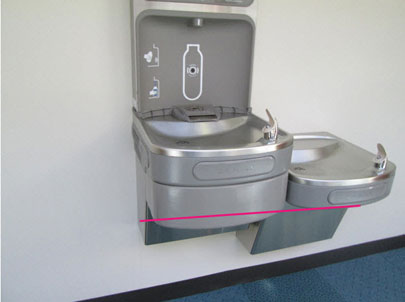
The cane detactable apron is lower than 27″ a.f.f. which reduces the knee clearance which is centered at the low drinking fountain
In order to not have that violation, the cane detectable apron must be mounted exactly at 27″ a.f.f.
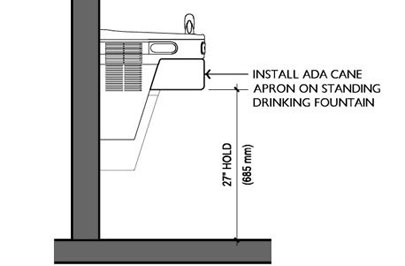
Post-mounted protruding objects
(this is not exactly examples of violations, but rather why it is not a violation)
The rules for protruding objects allows post or pylon mounted obects to project 12″ from its mounting surface. The figure below is from the ADA and TAS section 307.3 which shows the parameters of the protrusion limits.
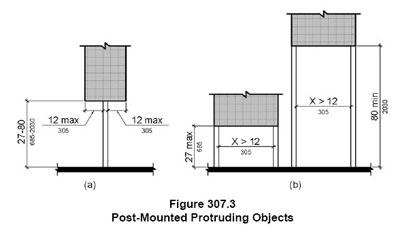
My example is from an interior play area where there was a statue of one of their characters mounted on a pylon or tall base. The statue had a little hand and pigtail that projected beyond the edge of the base. But because the ADA and TAS allows a 12″ protrusion limit along the circulation path, the statue was not a protruding object.
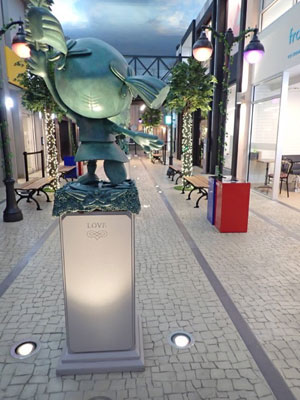
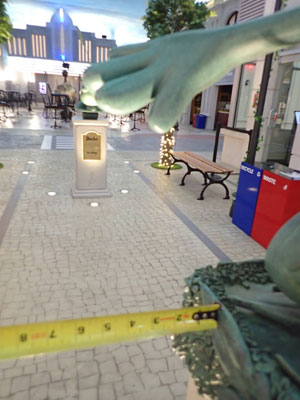
The little hand of the statue projected 6″ beyond the base, which was compliant.
Another example of a post mounted protruding object is a stand pipe located at a means of egress stair landing. Because the means of egress is essentially a circulation path it will require that the protrusion limits that the ADA and TAS describe in section 307 be adhered to.
The stand pipe in the photo below does have an extension where the valve is projecting more 12″ beyond the pipe and mounted higher than 27″ a.f.f.

The stand pipe is a protruding object because the valve projects more than 12″ from the post onto the circulation path
Pendant lights as protruding objects
Sometimes the protruding objects occurs because the object is mounted below 80″ a.f.f. Pendant lights can be protruding objects if mounted too low. The condition shown in the photos below shows a play room with furniture mounted below the pendant lights. The pendant lights are mounted at 70″ a.f.f. and therefore are protruding objects.
But you might be asking why is it a violation since the furniture acts as our cane detection?
Good question…
What is a misunderstanding is that the only cane detection that is allowed must be fixed or buil-in (see the requirement below)
201.1 Scope. These standards apply to fixed or built-in elements of buildings, structures, site improvements, and pedestrian routes or vehicular ways located on a site.
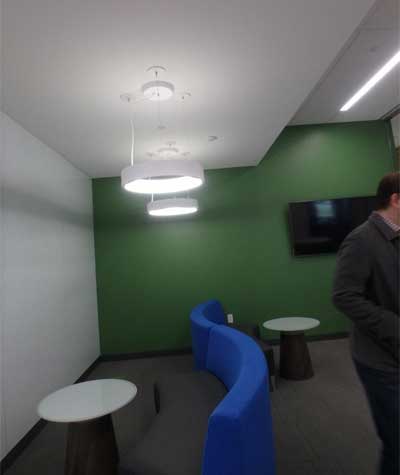
because the furniture below the pendant lights are movable and not built in they cannot be use as cane detection
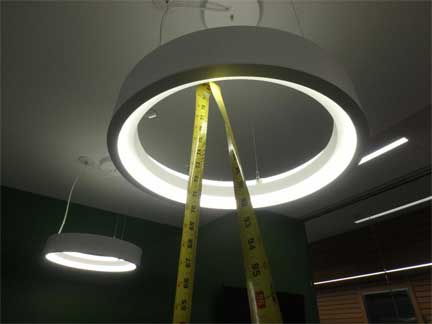
the pendant light is mounted at 70″ a.f.f. and is considered a protruding object
 Abadi
Abadi 
